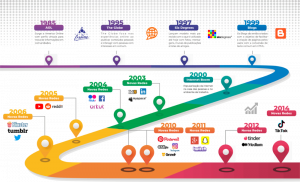32 Social Media and the Competitive New Job Market
Cade Rojas
32.1 Introduction
Keywords:
- LinkedIn – LinkedIn is the world’s largest professional network on the internet. You can use LinkedIn to find the right job or internship, connect and strengthen professional relationships, and learn the skills you need to succeed in your career.
- Online Presence– Online Presence refers to all activity and content a person or business has under their name on the internet.
Learning Objectives:
By the end of this chapter, students should be able to:
- Identify how social media affects applicants and employers.
- Differentiate between good and bad online presence.
- Understand how to build professional relationships through social media.
Social media has not only connected society as if it were one large community, but it has also revolutionized how employers and job candidates find one another. Although your typical résumé is still extremely important, today it comes second to building relationships and expanding your network. In fact, “send me your résumé” is often an afterthought after an introduction is made. In addition, recommendations go much further than a phone call to an old boss. Today, social media is a way that employers can either confirm or debunk any suspected risk of a candidate. This is extremely important because the costliest mistake a hiring manager can make is to hire the wrong person. To stay competitive in today’s job market, employers and applicants are forced to adapt to new social media sites by improving their search strategies, online presence, and communication style.
In this chapter you will become familiar with the ways that social mediaonline presence has impacted the modern hiring process and workplace. Since many hiring sites, such as LinkedIn, have now been created, this chapter will discuss the best ways to stand out amongst other local and global candidates. Furthermore, it will go into detail about the importance of online presence and communication to demonstrate how one’s social media can positively and negatively impact themselves and their company.
32.2 Search Strategies: The Needle in the Haystack
Key Takeaway
LinkedIn is an online platform launched in 2003 primarily focused on professional networking and career development. It allows job seekers to post their personal qualifications and employers to post jobs. LinkedIn allows members (both workers and employers) to create profiles and “connect” with each other in an online social network which may represent real-world professional relationships. This, however, is a sharp contrast to an ad in the paper or a help wanted sign at the front of the store. The majority of work opportunities are now found exclusively online. Nevertheless, this means heavier competition as well.
Because working from home and relocation have become increasingly popular, the pool of candidates available for a company position has increased tremendously. Therefore, recruiters rely heavily on social media sites and sites like LinkedIn to expand their search. On the other end, applicants can use these same sites to find openings in companies that directly fit their interest and skill set. However, because these sites have millions of users, becoming that “Needle in the Haystack” requires understanding how to build a relationship remotely. Therefore, your online profile and messaging must be consistent and authentic to avoid be marked as a red flag by recruiters. Sending out a vast number of applications is still a strategy that may land someone an interview; however, applicants will have a much greater chance if they utilize their business profiles as if it is their first impression.

“Social Networks Timeline” by Empvision is licensed under CC BY-SA 4.0
32.3 Online Presence: The good, bad, and ugly
Key Takeaway
There was once a time when everyone we met was a complete mystery. First impressions were created the moment we met them in person and opinions were created based on their personality and character. Before social media, what happened at work could stay at work and how you represented a company was reflected by how you presented yourself during business hours. Today, social media has completely transformed the world. Employers, workers, businesses, and governments all have some sort of representation on a social media platform in order to stay connected to consumers and society. However, there has been many drawbacks to the effects of social media in the workplace. The Internet has obscured the boundaries between people’s personal and professional lives, as more workers friend and follow their colleagues. The result is that employees may become privy to details about their co-workers’ off-duty activities, including their political affiliation, religious beliefs, drug use or participation in controversial causes, that otherwise would’ve remained private.
Research has indicated that employers now use social media such as Facebook and LinkedIn to not only make decisions about would be employees, but also to discipline current employees. There have been many public cases where an employee has posted something controversial and lost their job because of it. Furthermore, research shows that many applications have been completely thrown out if the applicant’s social media is filled with unprofessional behavior or strong political opinions, even if it is on their personal and private page.

“Management Presentation “ by BAUSCHRON is licensed under CC BY-SA 4.0
32.4: The Future Workplace
Key Takeaway
The future of social media influencing workplace decisions in on a steady incline. Because many work environments continue to transform to virtual workspaces through technological advancements, we continue to see new challenges and encounters that need to be overcome. One major contributor to the changing workplace is the fact that working from home has become increasingly popular. As discussed in an earlier chapter, Zoom and Microsoft Teams have been huge factors in allowing this to happen. However, if future employees will never have to step foot inside the company building, what kind of traits will employers be looking for?
Research has shown that some recruiters today are looking for more than just a good résumé and good communication skills. Today, a very admirable trait is the ability to adapt and overcome new obstacles. The unpredictability of social issues and technological advancements forces workers to remain current on social issues as well as up to date on new norms in order to remain professional and presentable in the modern workplace. Therefore, face to face interactions may become less common as more people work remotely, but a high level of communication between coworkers, businesses and even customers must always be maintained.
In the end, your online presence is extremely important for future workplace encounters. It is more difficult to understand someone’s personality virtually. Therefore, the more information you can share through a LinkedIn profile, or other forms of social media, limits the risk in the eyes of employers or other important people. It serves as an alternate “recommendation” to assure someone that you are who you say you are.

“Brooklyn Home Office” by Mackenzie Kosut is licensed under CC BY-SA 2.0
The Department of Psychology at Indiana University conducted a study to examine the opinions of 448 undergraduates on the use of social media for employment decisions. The practice of disciplinary action based on social media post has not only become popular in press, but it has also sparked several legal cases. Therefore, the goal of the study is to: (1) measure young adults’ perceptions of fairness of employers’ use of social media for making employment decisions, and (2) to examine how personality, individual differences, and personal social media use impacts such fairness perceptions. The study also dove deeper and reviled that 93% of recruiters said they were likely to look at the social media profiles of applicants and 43% have reconsidered a candidate based on the candidate’s social media profile.
The study participants were 144 men and 298 women around the average age of 20 years. Two-thirds of the participants were opposed to using social media in hiring and firing decisions. This, however, was the most common response among those open to experiences and more social environments. In other words, the participants that felt like they had something to hide were more worried about the practice of social media punishment. Because the study focused on the next generation of workers, it took interest in a variety of perspectives to predict how social media laws and policies will adapt to prevailing cultural attitudes. Will more legal cases come in response to social media punishment or will companies adapt their policies to protect themselves when taking such action?
Chapter Summary
Social media is here to stay and is becoming more and more prevalent in the workplace. In order to stay relevant and up to date as an applicant or employee, it is important to maintain a professional online presence through LinkedIn and other applications. This professional presence also clears the chance of getting punished by your employer for posting inappropriate content publicly that may hurt the company’s reputation. Furthermore, developing skills in communication and consistency through social media helps limit red flags in the eyes of recruiters. More important skills include being able to be able to adapt to working from home as well as competing against applicants that are not local.
Review Questions
1. How has Social Media created competition within the job market?
A. It has brought together friends and family
B. People are able to find what they are interested in
C. The number of applicants for an opening has increased tremendously
D. Online presence has become important
2. Which of the following is an example of bad online presence?
A. A strong and complete profile
B. Reposting things that you find interesting
C. Following the company that you wish to work for
D. Trash talking rival businesses
3. How do you create a good first impression online?
A. Respond in a timely manner
B. Wait 2 hours to respond to not look desperate
C. Display good qualifications even if they aren’t yours
D. Focus on the résumé rather than your profile
4. How has searching for a job been affected by technology
A. Relationships first, then résumé
B. An applicant must not be a risk on social media
C. Employees can now be local and nonlocal
D. All of the above
E. None of the above
F. Both A and C
Answers
- C
- D
- A
- D
Food for Thought
- As the digital era continues to advance, what traits will become more desirable to employers?
- For the job search and work environment, what concepts or personal traits will never expire with new technology?
References
Bradshaw, R. (2021, October 28). Statistics On Remote Workers That Will Surprise You (2021). Apollo Technical LLC. https://www.apollotechnical.com/statistics-on-remote-workers/.
Drouin, M. D. (2015, May 1). Facebook fired: Legal perspectives and young adults’ opinions on the use of social media in hiring and firing decisions. ScienceDirect. https://www.sciencedirect.com/science/article/pii/S0747563215000230
Flux, E. F. (2019, October 3). How to use LinkedIn effectively: Getting the best from the world’s biggest networking site. Mind Tools. https://www.mindtools.com/pages/article/linkedin.htm
Hill, J. E. (1998, September 1). INFLUENCES OF THE VIRTUAL OFFICE ON ASPECTS OF WORK AND WORK/LIFE BALANCE. Wiley Online Library. https://onlinelibrary.wiley.com/doi/epdf/10.1111/j.1744-6570.1998.tb00256.x
Miller, R. (2014, February 14). How social media has changed the way we find a career. Business Green Sponsored. https://www.businessgreen.com/sponsored/2328958/how-social-media-has-changed-the-way-we-find-a-career
Randy Villeda, M. M. (2019, February 11). Use of social networking sites for recruiting and selecting in the hiring process. Canadian Center of Science and Education. https://pdfs.semanticscholar.org/3f03/f1db77a7682af738befa63c49d85de7d6f29.pdf
Wade, J. (2018, March 23). Social media and selection: How does new technology change an old game? Clemson University Libraries Print. https://onlinelibrary.wiley.com/doi/epdf/10.1111/j.1876-3326.1768.tb00256.x
Waldman, J. (2021, April 5). 10 big differences between the job search of today and yesterday. CareerEnlightenment.Com. https://careerenlightenment.com/10-big-differences-between-the-job-search-of-today-and-yesterday
Online Presence refers to all activity and content a person or business has under their name on the internet.
LinkedIn is the world's largest professional network on the internet. You can use LinkedIn to find the right job or internship, connect and strengthen professional relationships, and learn the skills you need to succeed in your career.

